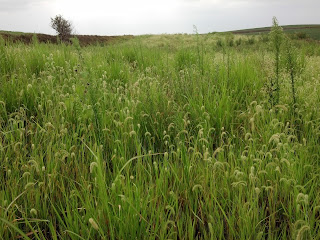The local IKM-Manning high school ag department was interested in using miscanthus grass in part of its renewable energy study. They needed some of the material to attempt to make experimental cellulosic ethanol out of it. We chose a 10'x10' area of a good stand of miscanthus grass in the highest planted population area. A majority of the leaves and tops of the grass had already fallen off the plants. We cut the grass manually about 2-6" from the ground and put the harvested miscanthus is a tub.
The harvested miscanthus was weighed at 21.4lbs. This is the as harvested weight and moisture content still needs to be accounted for. At this harvest rate, it could be expected to record approximately 9,300 lbs of biomass per acre.
The entire acre plot would not record this. This was from one of the best plots in the field, but a plot of how a biomass crop is expected to be when mature.
More to come on how the ethanol experiments go and how the miscanthus fares over the winter.
 |
| The harvested miscanthus |



